 |
About Germany
An Overview of the Rhine, the Swiss Alps and a Look
at the History of Germany
Written by Rick Archer
March 2014
A Note from Rick:
I have never been more excited
about a trip than I am about Rhine River 2015.
My reasons are
easy to list - the luxury of a Longship,
incredible scenery visible from the comfort of my cabin, and the benefits of
learning the history and culture of Germany, one of
the world's most important countries.
Marla and I understand that
river cruise trips
are expensive. The the lowest cost of a cabin
starts above $2,000 per person.
At the same
time, if you stop and think about it, a river cruise
promises
great value for your hard-earned money.
|
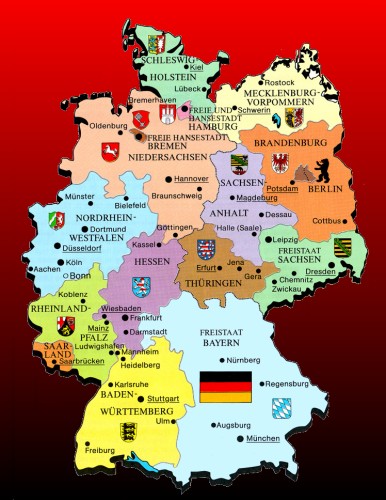 |
I am
absolutely convinced this trip will reward our
passengers with one of the best vacations imaginable, but I don't expect you
to simply take
my word for it. Therefore the purpose of
my "About Germany" article is to point out the
many things about this trip I think are interesting.
Hopefully you will
begin to share my view that
Germany is a fascinating place to visit.
Germany and
Switzerland are considered two of the most beautiful
countries in the world. I love mountains, I
love forests, and I love rivers. I also love
history. Germany certainly has all the above
in great abundance.
I also love
fun! I grin at the thought of
spending an evening in the
medieval town of
Rüdesheim drinking beer
with my wife and friends while we dance
the German Polka to an oompah band!
France is beautiful
as well. When we visit the
wine town of
Strasbourg, we will see how the French
have built their city around a river that passes
through the center of town. Bridges and canals
abound! One thing the Europeans do very well
is create beauty along the banks of their rivers.
Through careful landscaping and tasteful
architecture, Strasbourg is the
perfect example of a town that has made its lovely river
a work of art.
Speaking of
bridges and canals, what about
Amsterdam,
our last stop? This
fabled city is built on a river delta that brings
huge amounts of water to the center of town.
An intricate canal system featuring four concentric
rings of canals is the ingenious way the Dutch have
solved their water problem.
Rüdesheim,
Strasbourg and Amsterdam are just a few of the many
highlights on this trip. There are plenty more.
Before we
begin, I would like to share two small
coincidences.
|
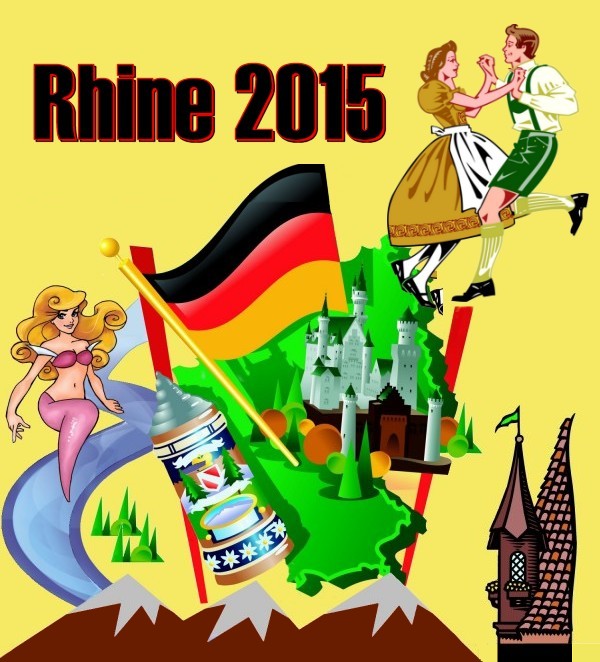 |
COINCIDENCE ONE
As most of you
know, in April 2014 we have
Rhone 2014, our
first river cruise. Rhine 2015
will be our second river cruise. During my
research, I learned that the source of the Rhine and
the source of the Rhone high in the Swiss Alps are
only 12 miles apart. A hiker can literally
walk from one spot to the other!
Considering the
Rhine finishes in the North Sea and the Rhone
finishes in the Mediterranean Sea 600 miles apart, I
think it is really cool that two rivers
separated by only a single valley can end up going
in two different directions and end up so far apart.
Then I had
another thought. Isn't it interesting how
closely these two trips are linked?
France and Germany - joined at the hip by the Alps
and the Rhine River. So much history together,
so much in common and yet century after century of
fighting.
At this very
moment, we are
witnessing the longest prolonged stretch of peace in
the entire history of these two amazing countries.
Let's enjoy it!
|
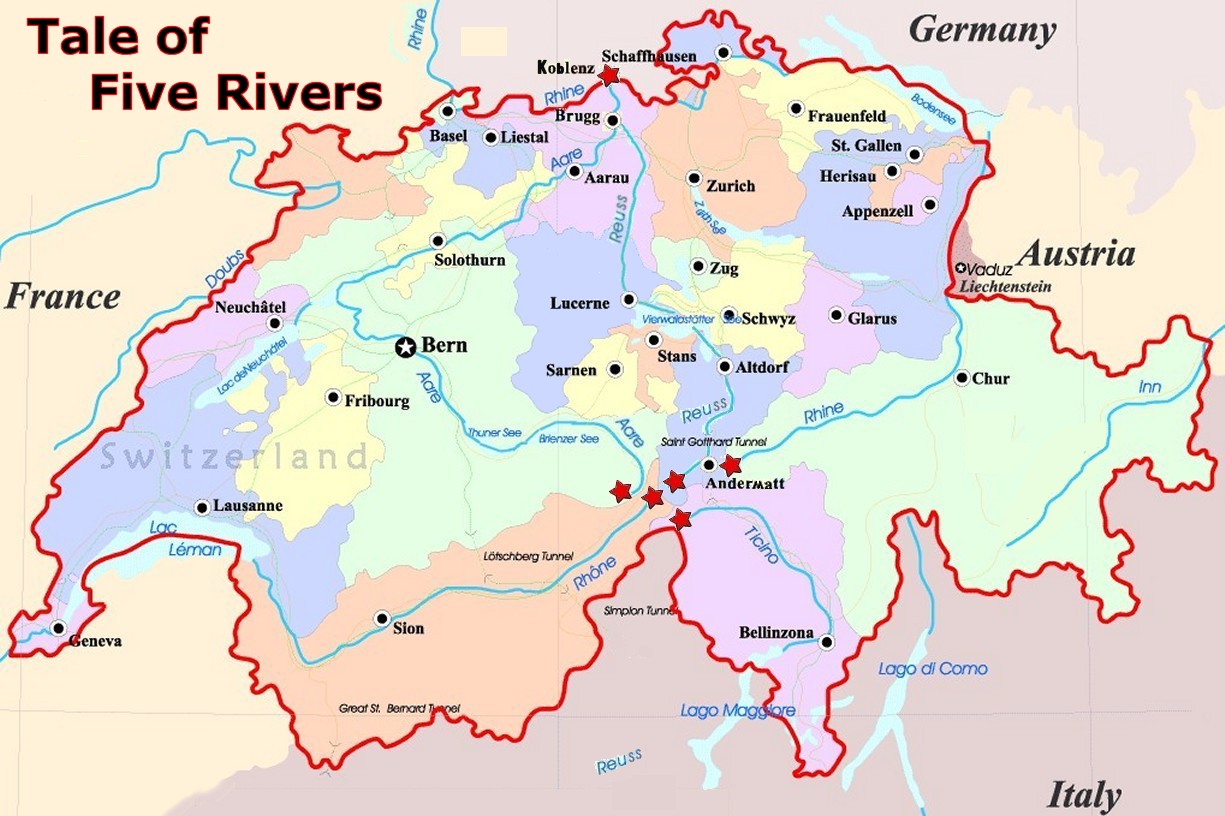 |
COINCIDENCE
TWO
On the
very same day that I published my story about Germany, I received an
email from Viking River Cruises announcing the christening of 16 new
ships. This event included the
Hermod (Rhone
2014) and the
Kvasir
(Rhine 2015), the
ships scheduled to take us on our back to back trips.
Here is
some of what the announcement said:
From:
Viking Cruises
Sent: Friday, March 21, 2014 1:58 PM
To: rick@ssqq.com
Subject: Viking Launches 16 New Ships in Europe!
16 VIKING
LONGSHIPS CHRISTENED IN 2014
MULTI-PHASED EVENT TAKING PLACE OVER 24 HOURS BREAKS WORLD
RECORD
Viking Cruises®
set a new world record with the inauguration of its newest
Viking Longships®.
In a
multi-phased event taking place over 24 hours, the company
christened 16 of its award-winning Viking Longships – nine were
christened in Amsterdam; four were christened in Rostock,
Germany; and three were christened in Avignon, France.
The
first-of-its kind ceremony was subsequently certified by a
GUINNESS WORLD RECORDS™ adjudicator as ‘The Most Ships
Inaugurated in One Day by One Company.’
Viking already held the previous record, having christened 10
new ships in one day in 2013.
All of Viking’s new ships will be deployed on its most popular
itineraries in Europe, and 2014 marks the first year that the
company’s award-winning Longships® will sail in France.
Since debuting in 2012, Viking Longships have amassed a long
list of prestigious awards. They recently topped Condé Nast
Traveler’s annual readers’ Cruise Poll for best river cruise
ships – with Viking Odin specifically being named the #1
top-ranking river cruise ship – and the entire class of vessels
was named “Best New River Ships of 2012” in Cruise Critic’s®
Editors’ Picks Awards.
The expansion of Viking’s fleet comes as a response to
increased traveler demand for destination-focused cruises.
(view
5 minute video of this inauguration)
It was a
cute video. It showed 16 different women cutting the ribbon to
release a champagne bottle to smash on the ship.
Incidentally, the announcement came as a complete surprise to me.
I had no idea what Viking was up to. That
said, I smiled at the knowledge Viking made all
these launches on the very same day I published my
Germany story. I took it as a good omen.
Personally speaking, I love coincidences. There is something
about coincidences that makes me wonder if there is more to this
world than meets the eye.
Why is Viking so Confident?
The
massive launch of new ships underscores a huge rise in interest in river cruises.
Apparently sales are going through the roof. This Cruise Critic
blurb is an
example of the fuss being made within the industry over river
cruises:
The biggest
name in the mid-priced tier of river cruises,
Viking
Cruises,
is holding fast to its traditional onboard offerings (price
includes shore excursions and beer and wine at meal times).
Viking
will be undergoing another huge expansion in 2014, adding 14 new
ships and new itineraries in France and Southeast Asia.
(cruise
trends)
Cruise
Critic was definitely correct about that huge expansion.
Not only did Viking christen 16 new ships on March 19, Viking
also
christened 10 new ships in 2013. That makes 26 new ships in two
years. Viking clearly
anticipates a surge in demand.
One has
to wonder what they know that accounts for their ambitious expansion
project.
My guess
is that they have done their homework. Their projections show the
general public has finally caught on that a river cruise is superior in many
ways to an ocean cruise.
I read an
article that said the river cruise idea is
fairly recent. Viking Cruise Line was the first to take the
concept global.
Viking started
in 1997 with several cruises on Russian rivers.
The idea took off like a flash and Viking has grown
as the interest has grown. The company has
concluded the general public is just now starting to
catch on. I suppose the word for that is "trending".
Viking anticipates a demand will kick in shortly and wants
to be ready to
catch the surge at its peak.
I wouldn't bet
against them. Marla is the expert. She's
the one who predicted Carnival was headed for rough
waters NINE MONTHS before their run of problems in
early 2013. On the other hand, Marla feels exactly the
OPPOSITE about Viking.
Marla
explained to me that Viking definitely knows what it is doing.
Based on her experience while organizing the
Rhone 2014 trip, Marla was
pleased to find this is the most efficient
cruise line she has ever worked with. Marla says Viking has an
intriguing business model and some of the most
creative ideas for creating customer satisfaction
she has ever come across.
MARLA'S FORESIGHT
So the
Viking Hermod was christened on March 19th and we sail on April
13th. Our
Rhone 2014 group of 34 will be
traveling on a brand new Longship making only its fourth
voyage.
How about
that for being in the right place at the right time?
Give the
credit to Marla. Marla made the right call on this "River
Cruise" idea before it became fashionable. I give my
wife high marks for taking her cruise group into 'river cruises'
a full
year
BEFORE the rest of the world figured it out.
At the
time of her decision, Marla understood that she was taking a chance asking people to
spring for a higher priced trip.
But her instincts said the trip was so special
people would
see it was worth the higher price. Here is how Marla explained it:
"Rick, half of an ocean cruise is spent on water looking at
nothing. What if there were no days at sea? What if a cruise constantly gave you something
wonderful to look at?
What if the trip visited areas of historical significance?
What if you could just step off a boat and walk directly to the
center of each town? What if the excursions were free and you
had the chance to actually learn
something about the places you visit?
What if there was
practically no wasted time and you never had to stand in a line?
What if you got all the wine you could possibly drink at each
mealtime? What if you never had to worry about
getting back to the ship on time?"
I smiled.
Very persuasive! I didn't hesitate. Sign me up!
Marla
made an educated guess that many people
in her cruise group felt exactly the same way she and I did.
If the idea knocked our socks off, Marla was sure other people would
feel the same way. Yes, a
river cruise would
cost more than an ocean cruise, but look at what we were getting in return!
So Marla
booked her first cruise, Rhone 2014,
a year ago. To her delight, Marla sold 17% of all the cabins
on the ship on HER FIRST TRY. In other words, a lot of people
agreed with her - a river cruise promised to deliver a vacation
experience on a whole different level. To heck with the cost;
the thought of seeing France / Germany on a river trip was well worth
taking a chance.
ABOUT MARLA
The Rhine
2015 River Cruise will mark Marla's 32nd trip. At this point, Marla
has as much cruise experience as any travel agent in Houston.
What makes Marla special is her thoroughness. Marla makes
sure every detail is covered for every passenger.
Most of
you know the legend of how Marla got started as a travel agent,
but if you don't, here is the
link
to Marla's bio.
I am
eternally grateful to Marla because she has given me a chance to see
the world. When it comes to travel, Marla is the most
knowledgeable person I have ever met.
I realize it is odd to say this, but I feel safe on these trips
because I know it was Marla who planned the trip.
I am comfortable because I know Marla has researched everything well
in advance. Every venue, every means of transportation, every
ground rule, what to bring, every money issue... Marla knows the all
the ropes and all the tricks.
In other
words, when it comes to these travel adventures, I am just like
everyone else in the group - I look to Marla to be our guide and
take care of us. There are so many things that
can go wrong on a trip that it is reassuring to have
an expert along.
I
consider Marla to be extraordinarily gifted at what she does. I will
say without hesitation that I consider myself incredibly
fortunate to have Marla as my leader. And you should too.
And now let's
begin our story
About
Germany
and the
Rhine!
|

This same Ribbon Cutting - Champagne Splashing
Christening Ceremony
took place 16 times in one day!

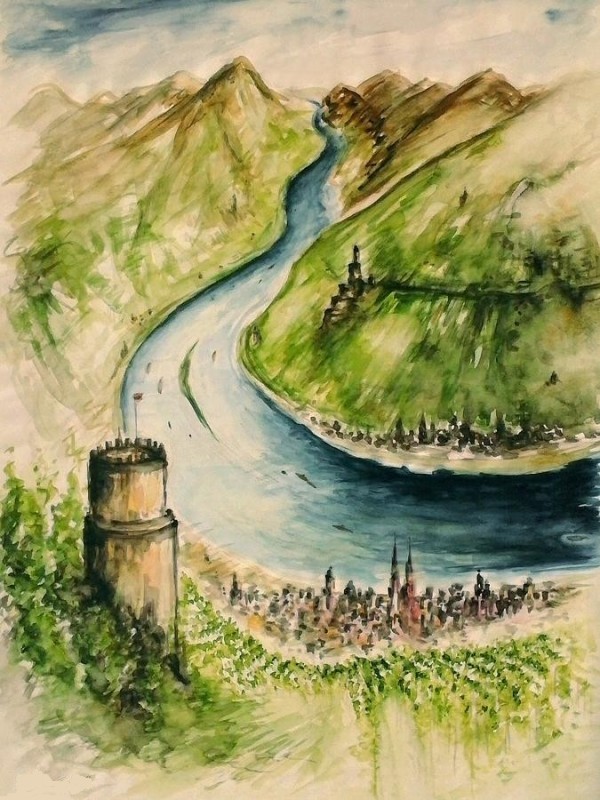
|
 |
CASTLES ON THE RHINE!
|
When asked what is special about the Rhine,
the first thing that comes to my mind is the constant
warfare.
Did you know the recorded
history of the Rhine started with Caesar's Gallia?
The Germanic people had no written language, but they did know how
to fight. Caesar warned Rome that "Germania" was
dangerous, but Rome didn't listen.
Germania would not only
begin the "Decline of the Roman Empire", Germania
would also
put the final stake in its heart.
The Rhine has seen centuries of
constant raids across the river and
countless war. As a way to deal with the threat of
yet another surprise attack, during the Medieval Era, the Germans built one castle
after another to keep the Franks out.
For that matter, the Franks
built one
castle after another to keep the Germans out. Consequently, today there are
castles upon castles looming high above the Rhine River. This
amazing spectacle explains why
our trip is called "Castles on the Rhine".
|
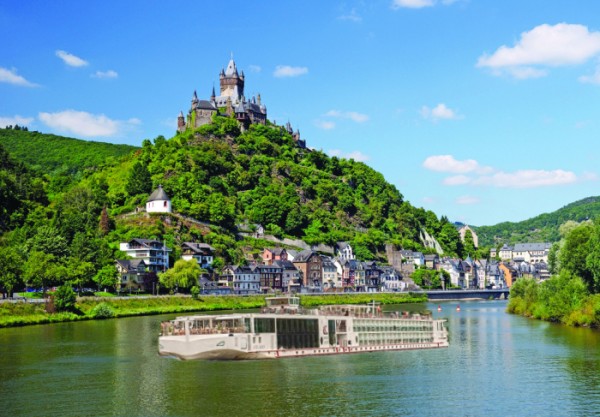 |
|
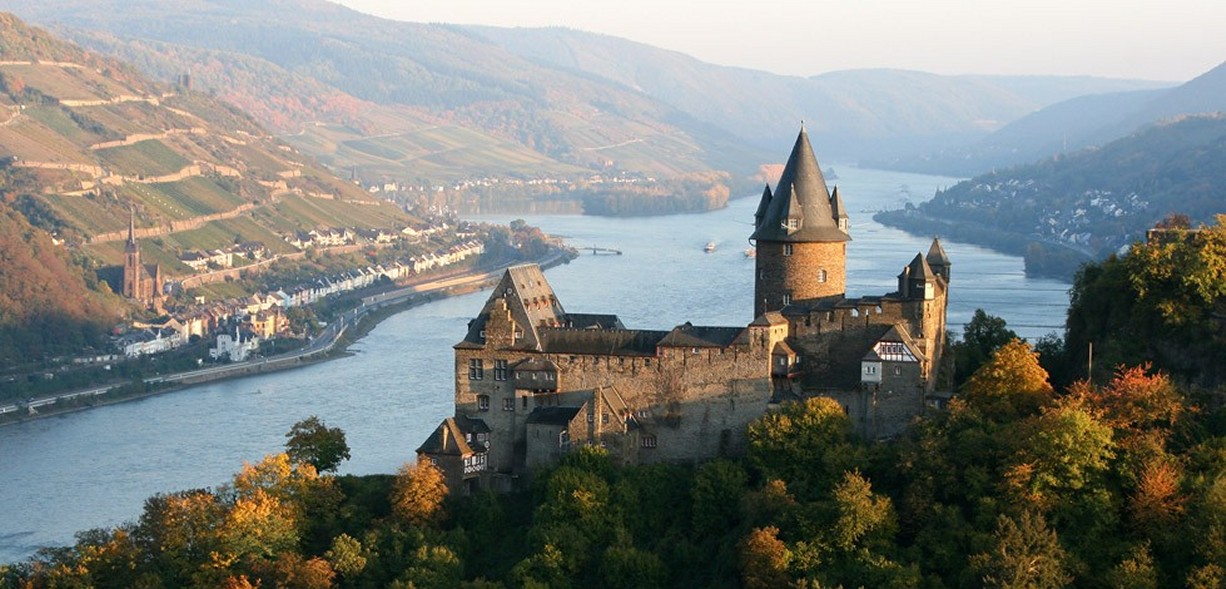 |
|
|
|
|
|
BURG KATZ AND LORELEI
ROCK
|
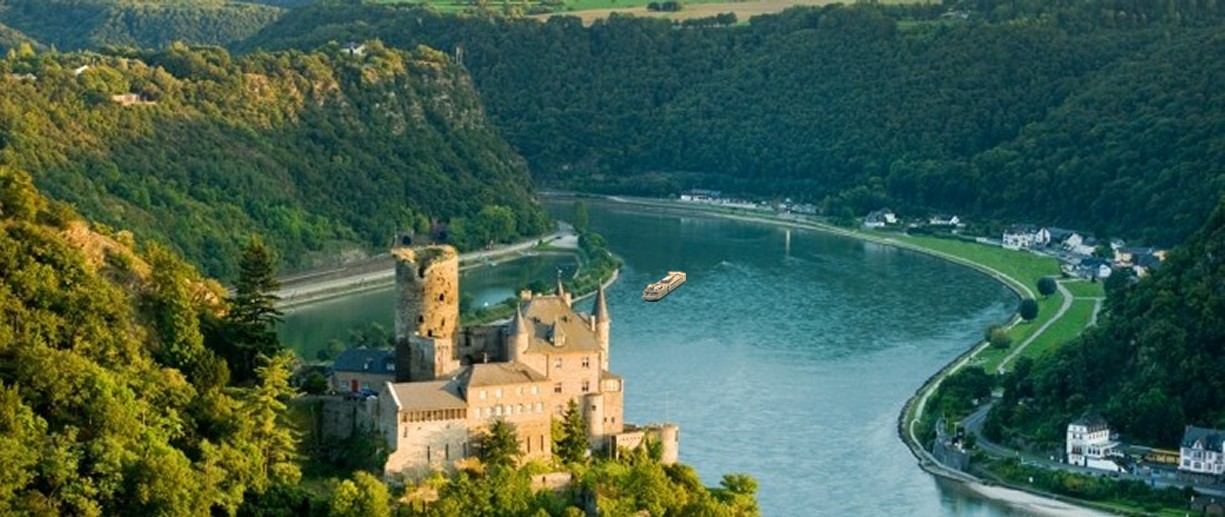
The Legend of
Lorelei Rock
|
|
 |
This imposing cliff is Lorelei Rock.
This outcropping is a
famous landmark on the Rhine River. It overlooks the
most narrow part of the river. Apparently many ships
have crashed here.
That faint
red
slash
in the background marks the presence of Burg Katz,
a magnificent castle located half a mile further down the
river. Burg Katz and the
Lorelei Rock are considered a pair. Together,
these two landmarks are the most photographed part of the Rhine
River.
In the picture above, note the depth of the river compared to the land
on top. In
a manner similar to America's Grand Canyon, over the
centuries the Rhine River has carved a huge valley out of
the soft slate rock. There are literally two worlds
here - the Land Above and the Land Time Forgot down at the river
level.
Lorelei Rock is the center of a long
stretch of the Rhine known as the Rhine Gorge.
Lorelei Rock is said to be the home of the Lorelei
Mermaids. Legend says that if you listen carefully,
you can hear an echo of their song.
So who are the Lorelei? They are beautiful
German mermaids who serve as the mythical counterpart to the
stunning but deadly Sirens of Greek mythology mentioned in Homer's Odyssey.
According to German legend, it started with a
woman who threw herself headlong into the river in despair
over a faithless lover. Upon her death she was transformed
into a siren. From that time on she could be heard singing on
this rock high above the Rhine River. Her hypnotic music lured
sailors to their death.
In 1801, German author Clemens Brentano further popularized the
legend with his sad story of a heartbroken enchantress.
In Brentano's poem, the beautiful Lore Lay, betrayed by her
sweetheart, was accused of bewitching men and causing their
death. She was found guilty.
Seeing the sadness in her eyes, the bishop took pity. Rather than sentence her to death,
he consigned her to a nunnery.
On the way to the nunnery, Lore Lay was
accompanied by three knights. By chance, they passed
what is now known as the Lorelei Rock. Lore Lay asked
permission to climb out to the edge and view the Rhine one last time.
She did so and then surprised the guards by throwing herself to her death. The
Norse Gods took note of her sorrow and transformed her into a
Siren. They made sure the rock retained a permanent
echo of her name.
Thanks in large part to an 1824 poem by the famed German
author Heinrich Heine, the Lorelei myth was expanded.
In Heine's version, it was no longer just one woman, but rather an
entire group of
maidens who sit upon this rock.
As these stunning women sit upon the cliff overlooking
the Rhine, they comb their long hair and sing their song.
As the sailors pass by, they hear the song of the Lorelei
and look up.
At this point, the Lorelei unwittingly distract the shipmen
below with their beauty and their song. The sailors
become hypnotized. They lose all
track of their task, thus causing them to crash to their
death upon the
treacherous rocks below.
The
Song of the Lorelei
Heinrich Heine
|
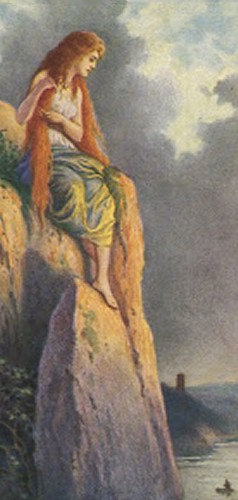 |
I know not, what does it mean
That I am so sad.
A legend of of bygone days
That I cannot keep out of my mind.
The air is cool and night is coming.
The calm Rhine courses its way.
The peak of the mountain dazzles
With evening's final ray.
The fairest of maidens is sitting
Up there, a beautiful delight,
Her golden jewels are shining,
She's combing her golden hair.
She holds a golden comb,
Singing along as well
An enthralling
And spellbinding melody.
In his little boat, the boatman
Is seized by it with a savage woe,
He does not look upon the rocky ledge
But rather high up into the heavens.
I think in the end
the waves will devour
The boatman and his
boat
And this by her song's sheer power
Fair Loreley has done.
|
|
|
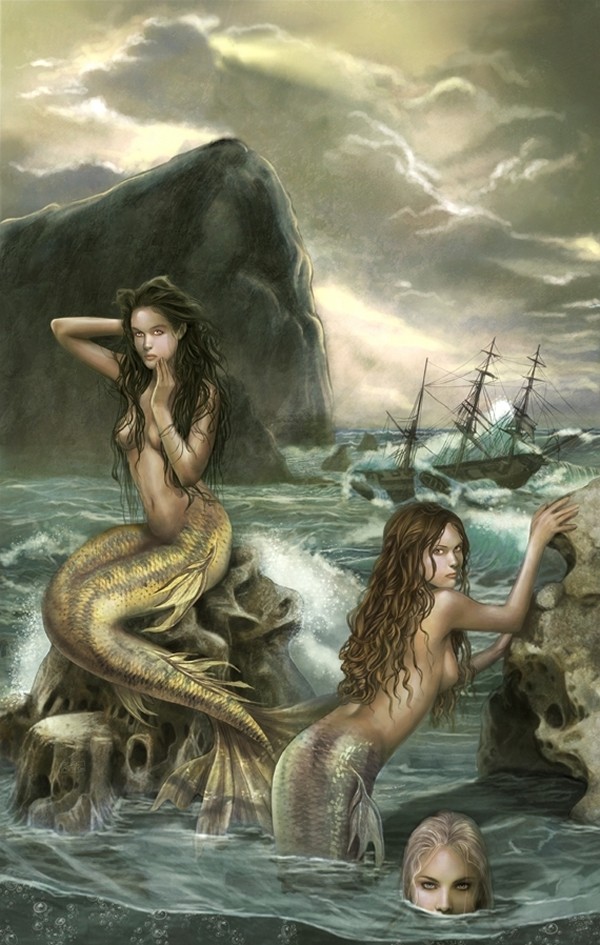
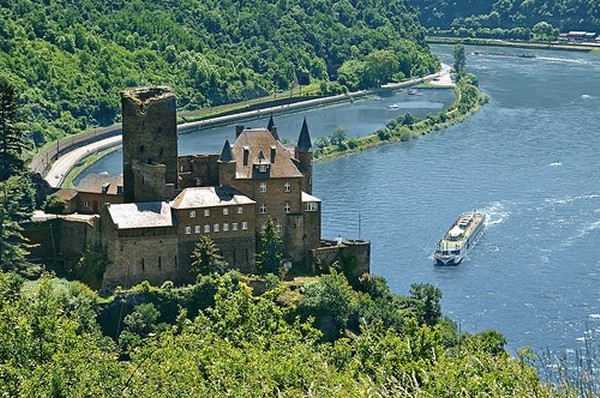
Burg Katz Castle and Lorelei Rock are a half mile apart.
These
two pictures show the castle and the Rock from different
directions.
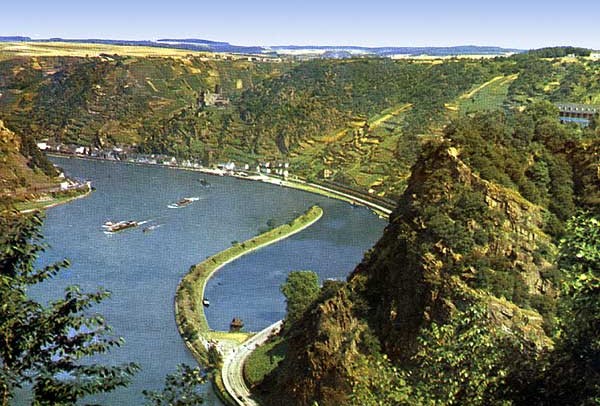
Burg Katz and Lorelei Rock are linked. As the most interesting point in the
60 mile long 'Rhine Gorge', this spot has
become the symbol of most river cruises on the Rhine.
Burg Katz and Lorelei Rock are easily
the most photographed segment of the entire river.
|
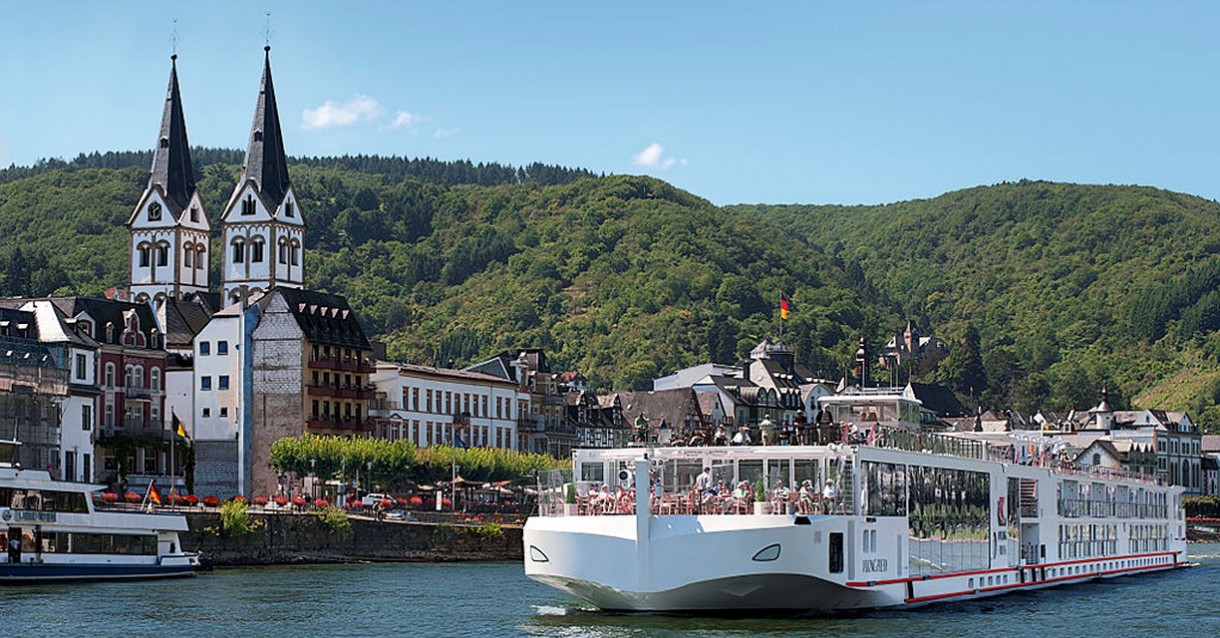
This
picture is a perfect illustration of the Two Worlds of The
Rhine Gorge. The Rhine has carved a canyon of sorts.
Up above is an entirely different world. It is the
modern world complete with cities and farms and highways and
traffic. Down below is the Land that Time Forgot.
The entire stretch of the Rhine Gorge is not only lined with
castles above, but down at the river level our ship will
pass one quaint "Old German" town after another.
There
is only one way to truly appreciate the spectacle of these
Medieval towns and the castles looming above, but I am not
going to tell you what it is.
Figure
it out.
|
The
Lost World of the Rhine Gorge
|
The Rhine Gorge is part of the Upper Middle Rhine
Valley. This halfway point on our journey is considered one of the most famous
locations in all of Germany.
Between
Rüdesheim, Koblenz and Bonn, the Rhine cuts
deeply through slate mountains to create a gigantic
canyon-like gorge.
The Rhine Gorge is
60 miles long. It is
lined with a seemingly endless string of castles, palaces
and vineyards stationed high on the hills above. The
Rhine runs through the area like a sunken ditch with 650
foot hills rising on either side.
This is also wine country. Many of the
steep slopes are
terraced with vineyards. For example, as the Rhine
passes the picturesque towns of Bingen and Rüdesheim,
one can see the vineyards lined with rows of grapes that
will create the
famous Rhine wines.
As the Rhine meanders
through hillside castles and steep fields of wine, it creates
a magical mixture of beauty and legend.
This is Germany’s landscape at its most dramatic – densely
forested hillsides alternating with craggy cliffs and
nearly-vertical vineyards that are perfectly terraced.
Idyllic villages
appear around each bend, their neat half-timbered houses and
Gothic church steeples seemingly plucked from the realm of
fairy tales to create a Lost World.
Meanwhile, half a mile above the river,
there exists a modern world
complete with highways, automobiles, rail lines, and farmers
who toil in
some of the richest soil Germany has to offer.
At the
crest of the hills on either side run a series of ominous medieval
castles. Today these castles loom over the river in
ghostlike silence. Some are ruined, some are restored, all are mysterious.
They serve as a poignant reminder of Germany's long legacy of
battle.
These castles are the remaining vestiges of a vicious era that was anything but
tranquil.
With increasing wealth, many
of these castles appeared when the
valley became a core region of the Holy Roman Empire.
Most castles were built by a mafia of local robber barons – knights,
princes and even bishops. These were men who extorted tolls from merchant
ships by blocking their passage with iron chains stretched
across the waters of the Rhine.
French troops under Louis XIV laid waste to many of
the castles during the Thirty Years War. Time
and erosion did the rest. Several castles were restored in the 19th century.
This was a time when Prussian kings, German poets and
British painters rediscovered the timeless beauty of the
Rhine Gorge.
There are many highlights along the way. The famous
Lorelei Rock can be seen two-thirds of the to Koblenz.
One mile past Lorelei Rock comes the incredible Katz
Castle. 12 miles further is the town of Braubach featuring the impressive
Marksburg Castle built so high it seems to touch the clouds
above. (Note: our ship will stop at Marksburg Castle
and visit it).
If you would like a recommendation, consider watching an
excellent 6-minute Youtube video on the
Rhine
Gorge. The accompanying Celtic music is exhilarating and
the pictures reveal the canyon-like phenomenon of this area
quite well.
The Rhine Gorge
is a strange place indeed. It is two worlds in one.
Up top are modern towns, wineries and farms that seem to have no
relationship with the Land that Time Forgot down below.
Down
below at river level are small towns that Time Forgot.
The Rhine has acted as an important trade route
through
central Europe since prehistoric times. Over time, a
string of small settlements has grown up along the banks.
Constrained in size, many of these old towns such as Rüdesheim
deliberately
retain their original historic feel today.
Indeed,
these little hamlets are living replicas of perfectly preserved "Old
Germany" architecture from medieval times. Here in this
time capsule the German cuckoo clock and
chalet-style buildings reign supreme once more.
Perched at the divide between the two worlds is the endless
string of castles that date back 700-800 years ago.
There is said to be at least one castle on every mile of the
Rhine Gorge. Built on cliffs and bluffs overlooking the river, they
seemingly guard the strange world below from the modern
world above.
If it were not for
the occasional barge traffic on the river, one might
completely forget this is the 21st Century. This Land
that Time Forgot is a
very weird, highly intriguing Lost World indeed.
Some say
this area is Romantic. Indeed, some unknown tourist agent has attempted to label this area
"The Romantic Rhine".
Personally, I think not. Too much blood has fallen.
The Rhine has long been an object of
frontier trouble. Back in the days of the Roman Empire, the
legions learned the hard way that crossing the Rhine was dangerous.
In 9 AD, the
Germanic tribes fought the Battle of Teutoburg Forest against
the Romans. This was one of the worst defeats the Romans ever
suffered.
The Rhine
Gorge was a major battleground of the Thirty Years'
War (1618-1648). This was one of the most destructive conflicts
in European history. The prolonged struggle against
the French left many
of the area's castles completely in ruins.
Napoleon
tried very hard to extend France's borders beyond the Rhine, but was
repelled several times by the Prussians.
No one
will ever forget the brave men on both sides who died fighting along
the Rhine during World War II.
Considering
all the bloodshed and all
the battles fought along the Rhine, this 'romantic' label
simply does not feel
appropriate.
Like it or not,
over the ages, the Germans have been regarded as warlike people.
Dating all the way back to
Germania in the
days of the Roman Empire, Germany has developed a
reputation as an aggressive and powerful nation.
This reputation
started with the Huns, Goths, Visigoths, Teutons and Vandals, fierce
barbarians who were a constant thorn in the side of the Romans.
Indeed, it was Alaric, King of the Visigoths, who ended the
Roman Empire with his sack of Rome in 410 AD.
Next came
the Teutonic Knights who became famous as the German
Crusaders. Then came the mighty Prussian warriors who created
the most powerful empire in Europe back in the 18th century. And of
course we know all about the ruthless
German soldiers of World War I and World War II. Much
has been forgiven, but those two wars will never be forgotten.
Today
Germany is a peaceful and prosperous land. However one suspects this
country
would quickly flex its muscles again if ever faced with a threat.
Therefore it is no surprise that the eternal presence of these
castles overlooking the Rhine has become a national symbol of
Germany and a source of great national pride.
Romantic
Rhine? I think not. A much better name for the Rhine
Gorge would be the "Valley
of the Castles".
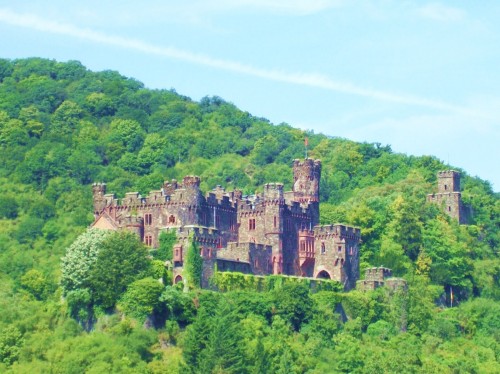
|

This
picture of
Lorelei Rock explains why this area is called the
"Rhine Gorge". The Rhine itself carved out this
enormous valley.
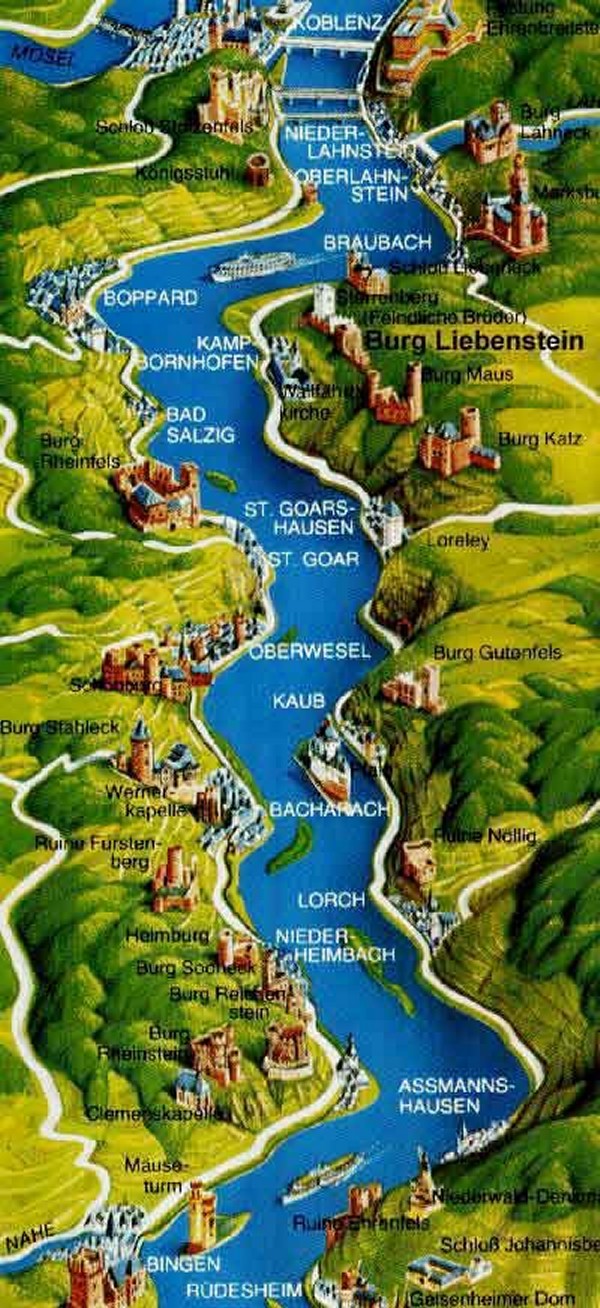
The Rhine
Gorge is said to extend from Rüdesheim to Koblenz, a 40 mile stretch
of castles, terraced vineyards and quaint towns.
However, Castle Row doesn't end at Koblenz. Indeed, past
Koblenz there is another 20 miles of castles extending all the way to Bonn.
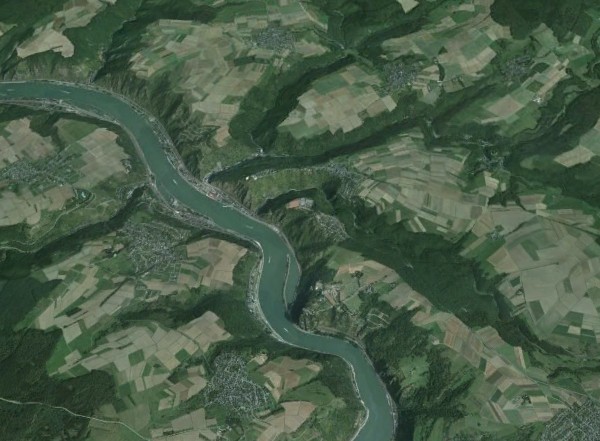
This
picture of
the Rhine River at
Lorelei Rock comes from Google Earth. It clearly demonstrates the two worlds
of the Rhine Gorge.
Down below is the Land that Time Forgot.
Notice the little white specks of ships as they sail down
the Rhine... one every half mile.
On the land above the river gorge one can see modern towns and acres upon acres of farmland.
These farms were surely
carved out of what once had to be a thick forest.
The Rhine Gorge cut through a part of Germany known as the
Palatinate Forest.
I believe that until the farms cleared
much of the land along the Rhine,
this area was once completely covered with a complete blanket of forest.
Note
how heavily forested the deep ravines are.
Furthermore, on the left of the picture, note how dense the
forest is. These hints suggest that during medieval
times the thick forest must have been nearly impenetrable.
This explains why the waters of the Rhine became Germany's
first "highway".
The Valley of the Castles is a very strange
world indeed.
|
|
The
Magnificent
Swiss Alps and its Rivers
|
 |
Rhine,
Rhone, Danube, and Italy's Po River
Did you
know the
Four Major Rivers of Central Europe
are
created by
the
Swiss Alps?
Rick's
Note: I went a little crazy on the Swiss Rivers.
My story grew so long that I moved this story to a
separate page:
The Rivers of the
Swiss Alps
|
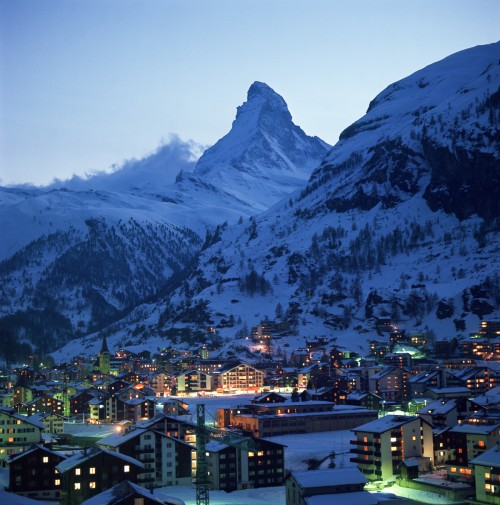 |
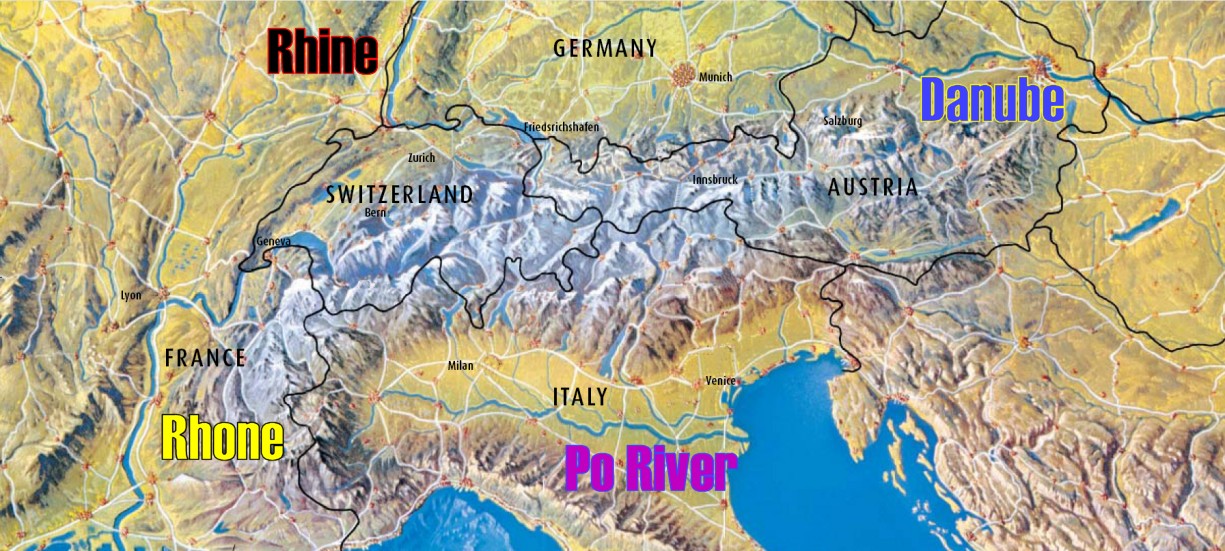 |
|
| |
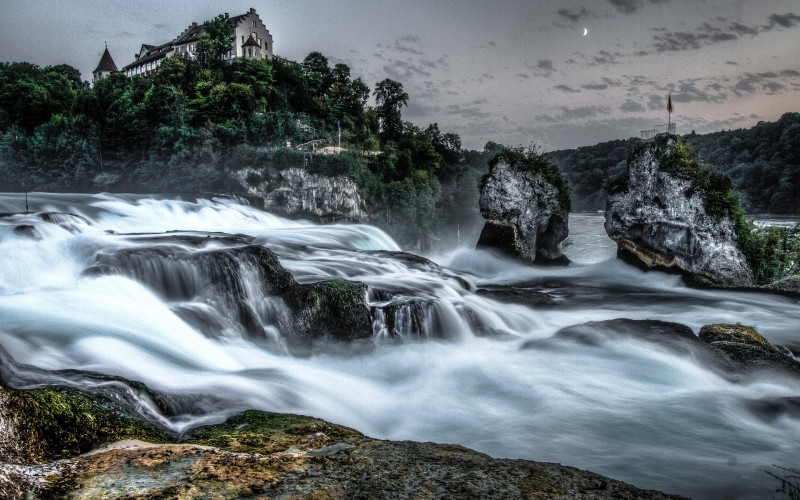 |
A
Look at the History
of Germany
|
|
|
 |
Rick Archer's Note:
Many of you will be
surprised to learn Germany did not become a nation until
1871. By that time, the United States was already 100
years old. The reasons are so complicated that only a
thorough retelling of the story will make any sense.
However, we can share one reason immediately...
it all dates back to the Roman Empire.
Although this is
an over-simplification,
basically when Spain, France, and England did eventually gain
their freedom from Roman domination, there was always one
main tribe in the territory that had worked closely with
Romans to keep order. By aligning their fortunes with
the Roman governors, when the Romans did finally leave, the main
tribe was ready to step into the vacuum and take over the
reins of power.
At the time of the Roman Empire, Germany was populated by
countless barbarian tribes that valued their freedom
fiercely. Unlike Spain, France, and England, the Roman
Empire was never able to
conquer Germany... or Germania as the Romans
called it. Rome came very close, but something very
strange stopped Rome in its tracks.
There was no leader in Germany when the Romans
left. This is because Germania was the only
province ever to forcibly evict Rome against its will.
Once Rome was gone, there was no central leader to take
their place.
Instead, there were many leaders and many
tribes, none of whom had the strength or the inclination to
take on the other tribes. Each tribe was left alone to
become strong within its own domain.
Without any central authority to say otherwise, Germany was
completely divided right from the start, a situation that
was to last for 2,000 years. As a result, the German territory was
free to take a radically different course to nationhood than
its neighboring territories.
Put on your seat belts. This is quite a story.
|
|
|
|